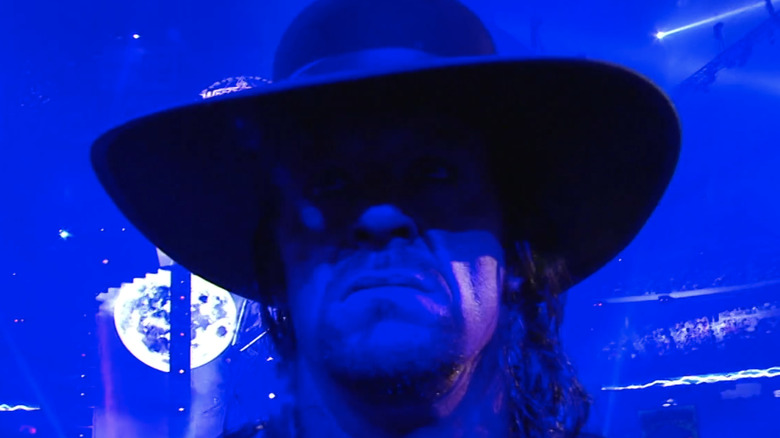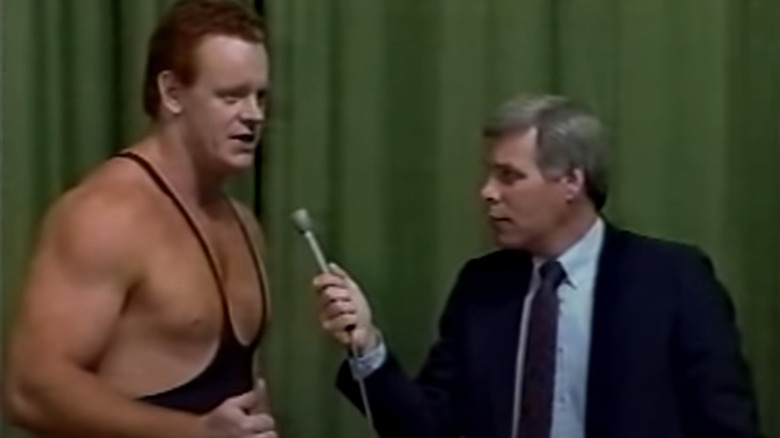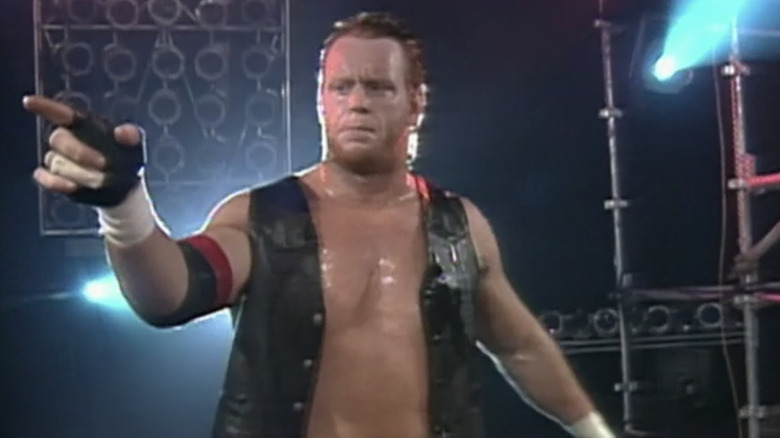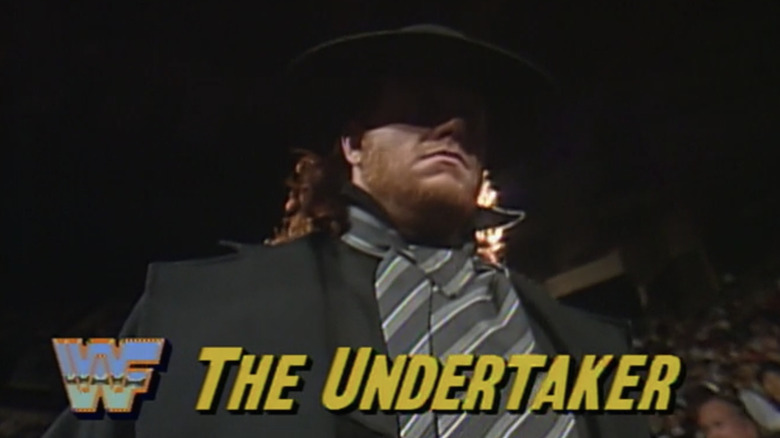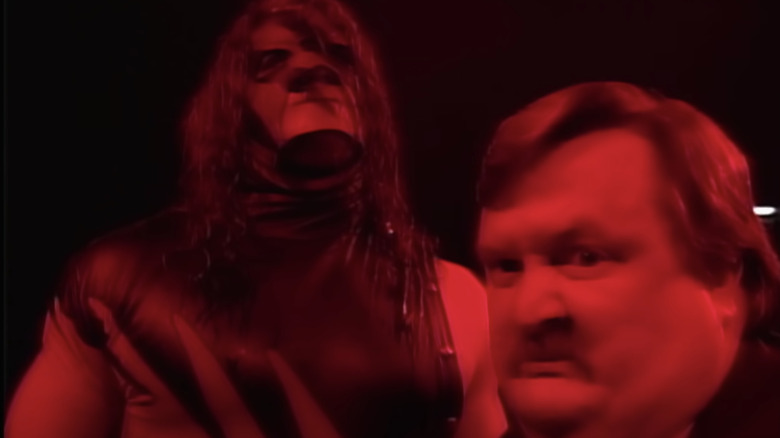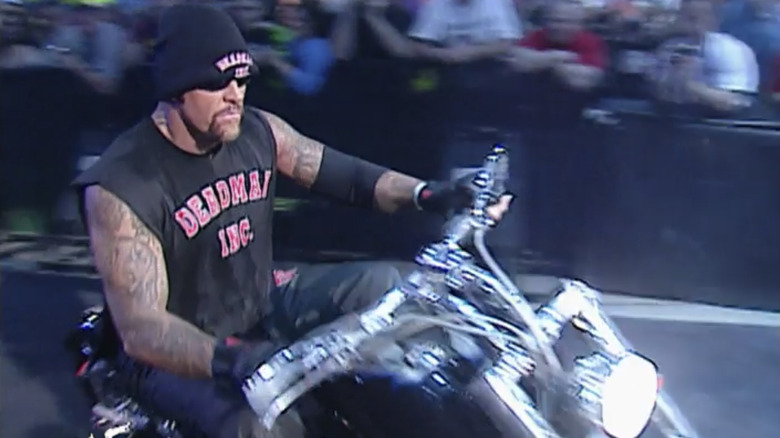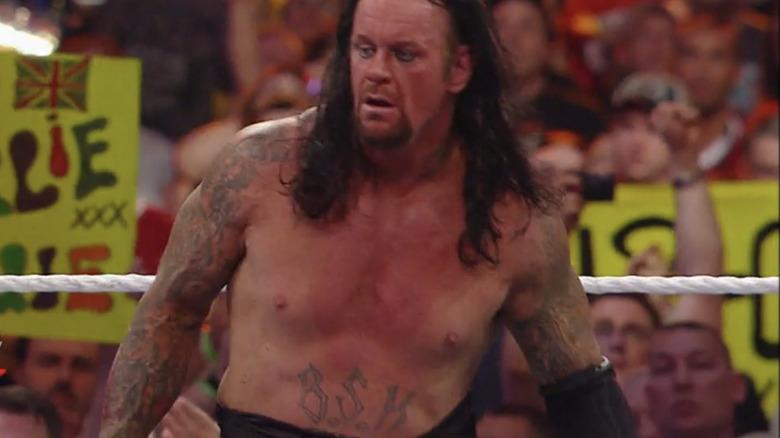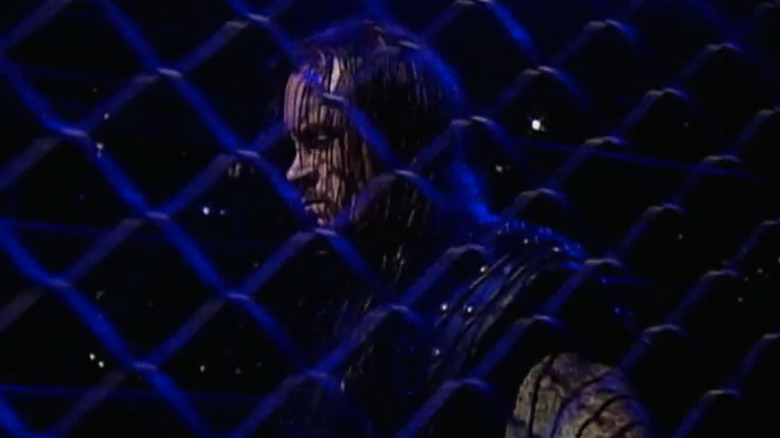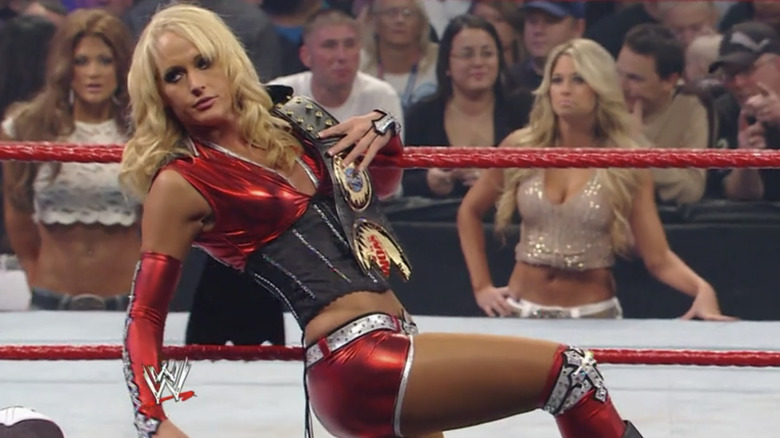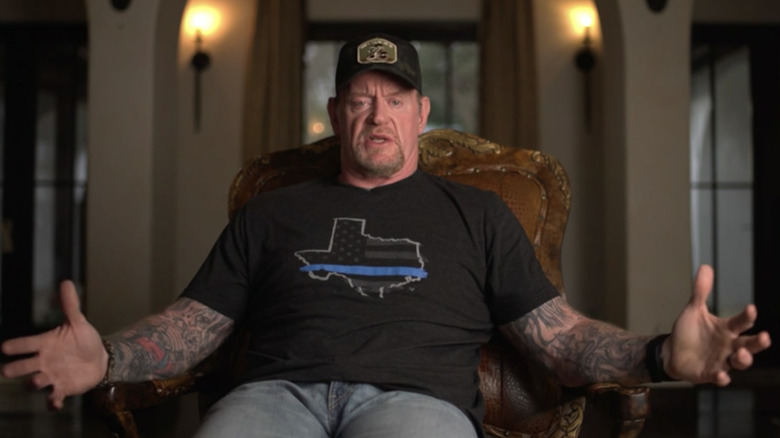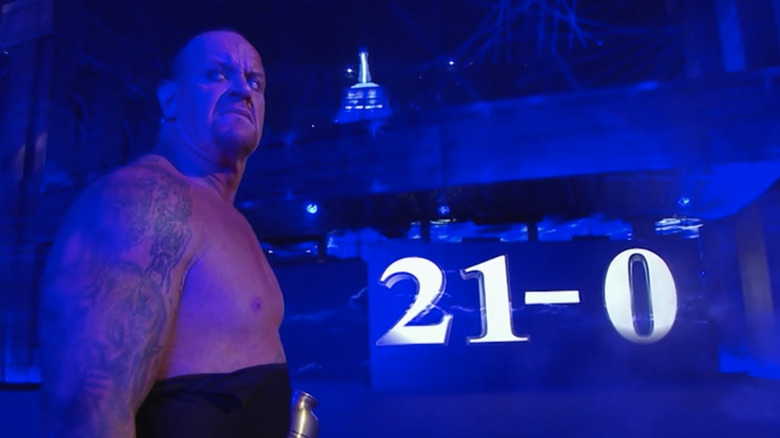The Untold Truth Of The Undertaker
For more than 30 years, the mysterious specter known as the Undertaker has been haunting the hallowed halls of World Wrestling Entertainment. He's a 7-time world champion who has laid waste to even the greatest wrestlers, a towering sports entertainment icon with the power to bring an audience numbering in the tens of thousands to their feet with a single strike of his gong. While he officially retired in 2020 after a career that spanned three full decades, his influence continues in the form of "Escape the Undertaker," a new interactive game from Netflix.
But who is the Undertaker, really? Die-hard wrestling fans who spend their days reading dirtsheets and listening to podcast interviews are likely familiar with the details of his career — but for others, the man born with the name Mark Calaway is as mysterious as the character he portrays. Since he's about to be exposed to a significantly wider audience, there's no better time to delve into the untold truth of the Undertaker, from his humble beginnings to the matches and storylines that made him famous. For those coming into this without a wrestling background, be advised: Professional wrestling is even weirder than you think it is, and the Undertaker is as weird as they come.
He started wrestling before he was properly trained
One does not simply walk into the wrestling industry. Wrestling might be choreographed, its results predetermined, but it's still an athletic physical endeavor that requires both strength and grace. It has less in common with football and basketball than it does with dance or stunts, and one wrong move can cause permanent and severe injury. Wrestlers, therefore, are not born. They are trained, and they're often trained for years before they start performing in front of actual crowds, let alone on television.
Of course, there are exceptions, and Mark Calaway was one. Officially, he was trained by "Mad Dog" Buzz Sawyer, but to hear him tell it, there wasn't much training to be had. There wasn't even a wrestling ring — Sawyer just beat up his recruits for a while on his front yard every time they showed up, until the day they showed up and he wasn't there. "We knock on the door one day, peek in the window, ghost town inside, he had packed up and moved to another territory," Calaway recalled in 2019. "Wrestling ring never got there. I'm still waiting on that wrestling ring."
Calaway's subsequent training happened, in the words of wrestling journalist Mike Johnson, "on the job," first as part of his local Texas territory, the World Class Wrestling Association (where he wrestled his first match under a mask in 1987), and later in the United States Wrestling Association in Memphis, where he was known as "Master of Pain."
He was told nobody would ever pay to see him wrestle
Calaway's early career setbacks weren't limited to the dubious training style of Buzz Sawyer. He also had to deal with one of wrestling's most prominent figures telling him, to his face, that he would never make it. In 1989, Calaway debuted for World Championship Wrestling (WCW), which was owned by Ted Turner and which would, years later, memorably challenge Vince McMahon and the WWF for dominance over the televised wrestling industry. By the time that happened, however, Calaway had long since jumped ship. Working as "Mean" Mark Callous, he had started out in WCW as part of a tag team called the Skyscrapers, but his tag team partner abruptly quit the company in early 1990, leaving him a solo act. When it came time to negotiate a new contract, Calaway met with the WCW brass, which included legendary wrestler Ole Anderson.
"He looked me square in the eyes and didn't blink when he said it," Calaway says. "He said no one will ever pay money to watch you wrestle. And I knew at that point, like, okay, I'm done here."
Calaway quit WCW, and in November that same year, he made his debut in the WWF (subsequently the WWE). He would spend the next 30 years proving Ole Anderson wrong.
He's always been the Undertaker in WWE
Before his arrival in the WWF, Mark Calaway had gone by many different names in the wrestling industry. He wrestled his first five matches as Texas Red — for a single match in South Africa, he was Texas Red Jack. Following his stints as the Master of Pain, he became known as the Punisher, which became Punisher Dice Morgan during his time in Japan. And of course, there was Mean Mark Callous, later shortened to just Mean Mark. When he debuted for Vince McMahon's Survivor Series in 1990, however, he was introduced as the Undertaker, and while various elements of his look and character would be changed over the years, the name has remained the same. Unlike many, many wrestlers over the course of WWE history, the Undertaker has only ever had one moniker on television.
Or at least, that's what most people think. Technically, it's true that Calaway has always been known as the Undertaker in WWE, and he did debut under that name at Survivor Series. What you might not know is that after Survivor Series, WWE briefly toyed with the idea of giving him an actual name in addition to his title. For two episodes of "WWF Superstars" and three episodes of "WWF Wrestling Challenge," Calaway was introduced as "Kane the Undertaker." The "Kane" part didn't stick — but as we'll see, somebody backstage clearly liked it, and it would become a name associated with the Undertaker for years to come.
His character is straight out of a horror movie
Professional wrestling has never been afraid to include supernatural elements, and the Undertaker has gone on to become the WWE's premiere supernatural character. Early in his career, he was given a manager in the form of Paul Bearer (you see where this is going), a spooky funeral director who carried a mystical urn from which the Undertaker drew his power. Undertaker himself seemed to have supernatural abilities of his own — he could call down lighting, was largely impervious to pain, and was buried alive on several occasions, only to come back from the dead. As time went on, his backstory began to expand, along with his supporting cast, including arch-nemesis Mankind (a lunatic who lived in boiler rooms) and Kane (his masked half-brother, horribly scarred from a fire in the family funeral parlor that killed their parents and that each accused the other of starting). It would later turn out that Kane's real father was, in fact, Paul Bearer.
By the time the late 1990s came around, Undertaker was the leader of an evil group called the Ministry of Darkness and engaged in more heinous shenanigans, including "crucifying" Stone Cold Steve Austin with the help of some druids and attempting to marry an unwilling Stephanie McMahon, Vince's daughter, before sacrificing her in a black ritual. Of course, it was eventually revealed that Vince himself was leading the Ministry, a development that would lead to Undertaker actually dropping the supernatural gimmick for the first (and only) time.
He spent some time as a biker
In late 1999, the Undertaker suffered an injury that kept him out of the ring for several months. When he returned, interrupting the main event of Judgment Day 2000, he was portraying a different character — one that wrestling fans casually refer to as "Bikertaker." Still called the Undertaker, he had nonetheless ditched the gothic attire and special effects in favor of sunglasses, a bandana, and a motorcycle, which he rode to and away from the ring. Instead of an undead monster, he was a redneck ass-kicker, as liable to beat you up backstage as he was to beat you in a match. When the Bikertaker first made his triumphant return, WWE referred to him as "the American Bad-Ass," but when he became a villain, he was given a simpler nickname: Big Evil.
While on its surface it was strange to see the former zombie mortician/cult leader driving a motorcycle around the arena and acting as human as any other 6'10" professional athlete, the Bikertaker era is remembered fondly by fans as one of the best of the Undertaker's career. Freed from the shackles of the supernatural storyline which WWE only occasionally did well, he was able to become a much more compelling and relatable part of the show, and could actually put his wrestling ability on display. It was something of a shame when, in 2004, he reverted to the old magical version of the Undertaker, never to return.
He was part of a backstage group called the Bone Street Krew
Everybody knows about the Ministry of Darkness, but fewer wrestling fans know about the Bone Street Krew. It helps that the BSK was never actually a thing on television — it was a wrestler clique that were friends behind the scenes who hung out together backstage. Initiated by the late former world champion Yokuzuna, the other members of the group included the Undertaker, Rikishi, the Godfather, Henry O. Godwinn, Savio Vega, Brian Adams, Paul Bearer, and Mideon. Yokozuna and the Undertaker were reportedly the ones who decided which wrestlers received entry into the BSK — the name was derived from the fact that several of the group's members enjoyed playing dominoes together backstage.
There was actually a much more famous gang of wrestlers who hung out backstage together in the WWF in the 1990s. Simply known as the Kliq, this group, which consisted of Shawn Michaels, Triple H, Scott Hall, Kevin Nash, and Sean Waltman, became famous for breaking kayfabe — the old wrestling tradition of never publicly acknowledging the difference between performers and their characters, which today is a distant memory. The BSK never did anything to etch their names in the history books as a unit, but they did all get BSK tattoos. Keep an eye on the Undertaker's midsection whenever it's exposed, usually after he pulls down the straps of his singlet during a high-profile match, and you'll see his stomach proudly proclaiming "BSK Pride."
He's associated with unique matches
One of the things that makes the Undertaker stand out in wrestling history is his association with a variety of strange and rarely-used matches, each with its own eerie stipulation. Some, like the casket match — in which the goal is to lock your opponent inside a casket — had been around for years before the Undertaker showed up, but his gimmick made him a natural fit for it; he even came up with his own variation called the Last Ride match, which involved a hearse. Others, such as the Buried Alive match, the Boiler Room Brawl, and the Inferno match — this last featuring a wrestling ring surrounded by flames — were created specifically for the Undertaker and his various supernatural opponents. One in particular, however, stands out: Hell in a Cell.
As opposed to a traditional cage match, in which the cage prevents exit from the ring by sitting on the ring apron, Hell in a Cell is larger structure that allows wrestlers to fight outside the ring and on the roof. The Undertaker was in the first one, which also saw the debut of Kane, and the most iconic one, which saw Mankind thrown from the top of the Cell to crash through a table below. He's also participated in more of them than any other wrestler, despite the fact that the popularity of the Hell in a Cell match has made it a regular event on the WWE calendar.
He's married to a wrestler
The Undertaker has been married three times, and two of his wives have appeared on WWE television. His second wife, Sara, had a brief but memorable storyline in the summer 2001, in which she was being stalked by obsessed Undertaker nemesis Diamond Dallas Page. She served as the Undertaker's valet during their feud, and even technically owns a victory over Page herself — though Page had been destroyed outside the ring by Undertaker prior to the start of the match, which lasted six seconds from bell to bell.
The Undertaker's third wife, on the other hand, was actually one of the more decorated female wrestlers of her era. Michelle McCool didn't exactly arrive in the golden age of WWE women's wrestling — when she was in her prime, the women's division was largely an afterthought, and didn't get very much time on television. That having been said, McCool was among the most prominent women in the company from 2008 to 2010 — she was the inaugural Divas champion and became the first woman to hold both that title and the original Women's championship, and she would later end up unifying the two titles. She was also one half of an extraordinarily entertaining act alongside her partner, Layla El; the two were known as LayCool. McCool retired from wrestling in 2011.
He's controversial
For all the Undertaker's accolades, he's far from universally beloved within the community of wrestling fandom. In recent years, as he's transitioned out of wrestling and returned to being Mark Calaway, his political beliefs (and his political donations) have come under scrutiny, particularly due to his wardrobe choices while being interviewed for the WWE documentary series "Undertaker: The Last Ride." Beyond the realm of politics, however, there's a different kind of division among wrestling fans regarding the ultimate legacy of the Undertaker as a performer — specifically, whether or not he tainted it by sticking around too long.
There are those who argue (some quite eloquently) that the Undertaker's wrestling career wasn't terribly impressive in the first place, but even his staunchest fans were probably ready to let him go by the end. In 2017, the Undertaker, then 52 years old and only appearing a few times a year, lost a match to Roman Reigns at Wrestlemania 33. Afterward, he left his hat, coat, and gloves in the ring, signifying his retirement. According to Calaway, he fully intended to retire, but the poor quality of the match spurred him to return. He ended up performing eight more times, with half of those matches taking place at WWE's controversial Saudi Arabia shows. His last "match" ended up being a purely cinematic showdown with AJ Styles at Wrestlemania 36, which had no fans in attendance due to the COVID-19 pandemic, and it was by far the best of the lot.
He was undefeated at Wrestlemania for 20 years
Wrestlemania is WWE's signature event, and has been since the first one made Vince McMahon the king of the wrestling industry in 1985. And when you think of the Undertaker, you think of Wrestlemania.
That's because one of his greatest achievements was The Streak — a consecutive series of Wrestlemania victories that lasted from 1991 to 2013. For the first decade or so of his career, it wasn't necessarily a huge deal that the Undertaker had never lost at Wrestlemania. Most of his early wins were against lackluster opponents, and The Streak itself was never a part of the storyline going into the event. That changed in 2005, when a wrestler named Randy Orton declared that he would be the first to defeat the Undertaker at Wrestlemania, kicking off their feud, as well as a new era that would see the Undertaker spend every Wrestlemania thereafter defending The Streak against the latest challenger. From 2009 to 2012, all four of his Wrestlemania matches were built around the question of whether The Streak would end. His last successful defense came in 2013, when he defeated CM Punk to get to 21-0.
In 2014, The Streak was ended by the monstrous Brock Lesnar, and the Undertaker (who suffered a concussion during the match) was never really the same. Still, The Streak remains an unmatched accomplishment, and emblematic of what the Undertaker embodied in WWE: A larger-than-life figure who will never, ever be forgotten.
